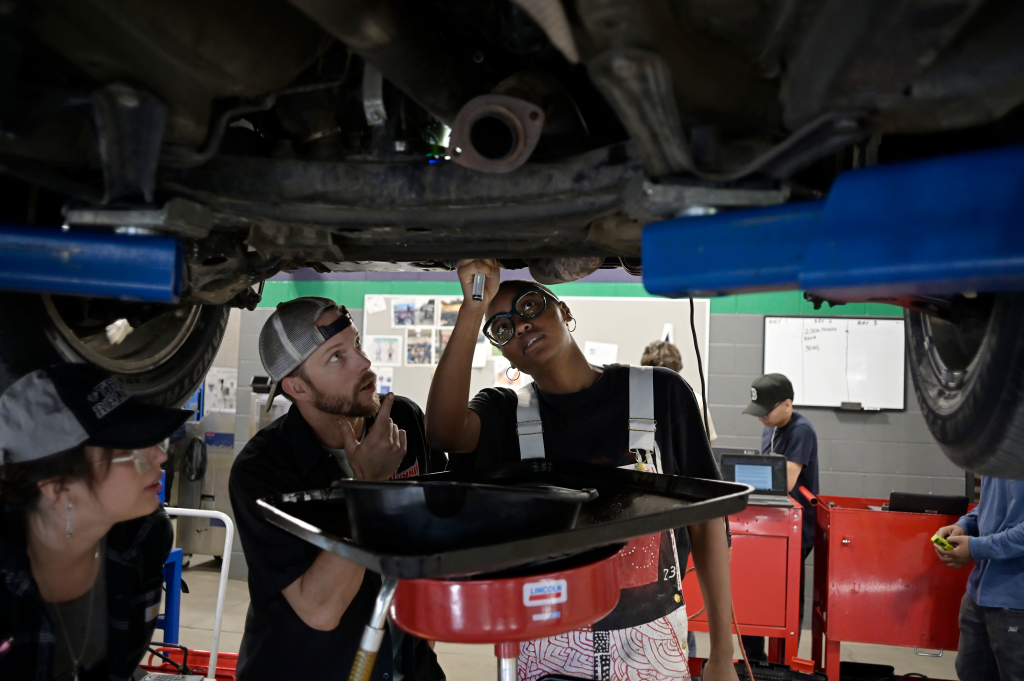
When Emily Griffith Technical College had an opening for a heating, ventilation and air conditioning instructor last winter, the school posted the job on LinkedIn, emailed relevant advisory committees, advertised on trade association websites, notified graduates and reached out to HVAC specialists in the community.
The position sat vacant for six months. The students at the Denver college who were waiting to learn the popular trade saw their program paused, stalling their education.
“Whenever you have a vacancy for an instructor position, it’s really hard to find candidates,” said Gideon Geisel, Emily Griffith’s dean of trades, business and technology. “You turn over every possible stone you can think of, and usually it takes a really long time — and that, ultimately, does impact students.”
Emily Griffith Technical College is the public postsecondary and adult-education arm of the Denver Public Schools system and one of three technical colleges in the Colorado Community College system. The school offers various career and technical education, or CTE, certificate programs like barbering, welding, water quality management and computer networking.
Career and technical education, the product of what are more commonly known as trade schools, is now offered in middle schools, high schools, community and technical colleges, and even some four-year universities across the country.
Due to instructor shortages, Emily Griffith has been forced to close programs — most recently, a program on computer-aided design and building information modeling.
The college employs about 26 full-time and 40 part-time credentialed instructors. Substitute instructors provide support when needed. At the moment, Geisel said, the trade school is fully staffed, but that doesn’t account for the long waitlists its programs have. Administrators anxiously await the next staff vacancy, knowing it could mean another program closure or indefinite pause.
The technical college has experienced long delays between losing an instructor and hiring another, resulting in program interruptions and delayed completion for students, including in accounting, massage therapy and automotive services.
To help remedy the problem, state officials are looking to coax trade workers out of retirement or entice aging employees with labor-intensive jobs to take on the less physically taxing career of instructor at Colorado’s trade schools.
The ongoing CTE instructor shortages at Emily Griffith are emblematic of a nationwide problem compounded by growing popularity in career and technical education, but not enough instructors to meet that demand.
“This is not isolated to Emily Griffith,” Geisel said. “This is a metro-area-wide challenge, a statewide challenge, a nationwide challenge. It’s one thing to have the student demand for it. It’s another thing to have the supply to meet the demand.”
Teaching a new generation
Colorado supported 162 CTE programs across 143 schools and 50 districts during the 2023-24 academic year for the more than 125,000 CTE students enrolled in high school, according to state data. For postsecondary options, the state offered 716 CTE programs across 20 community and technical colleges, as well as in the Department of Corrections.
Schools in the state awarded 21,005 postsecondary CTE certificates and associate degrees during the 2023-2024 academic year. Nearly 80% of employed graduates are working in an occupation related to the CTE program they completed, with median wages ranging from $54,550 in construction to $80,760 for a registered nurse, according to state data.
Corbin Lewis hopes to be among the CTE graduates soon. The 19-year-old is a welding student at Emily Griffith who hopes to work on a pipeline to gain experience before owning his own rig and starting an oil and gas company.
The teen took a welding class at Douglas County High School and found he enjoyed working with his hands more than traditional book learning. His father and grandfather both worked in trades, and he intends to follow in their footsteps.
“You’re getting to do what you would do out in the field,” Lewis said. “It’s a really good community around here.”
In the automotive services wing of the campus during a recent visit, a group of students huddled beneath a vehicle perched on a hydraulic lift, wielding tools as they learned about changing transmission oil.
Gary Kreider has been an automotive instructor at Emily Griffith for two years. He was previously the shop foreman at a local Toyota dealership for nearly 40 years.
When his body told him it was time to get out of the labor-intensive job, the 63-year-old heard about a trade instructor position through which he could pass along his expertise.
“I physically wanted out, but I still had something to offer a new generation,” he said.
Kreider is refreshed to be teaching young folks who are engaged in mechanic work. At the dealership, he said he struggled to fill positions, but now he’s on the other side of the pipeline, imparting his knowledge onto bright, eager learners.
He enjoys the teaching aspect, but there’s an unexpected bonus he’s come to cherish: vacation time.
Kreider went from working 60 to 70 hours a week at the dealership to about 40 hours a week with the bonus of academic-calendar vacations.
“I’ve never had that much time off in my whole career,” he said.
An ‘encore career’
A lack of skilled instructors means schools can’t train the next generation of electricians, HVAC technicians, welders and other professionals.
The implications are far-reaching, Emily Griffiths’ Geisel said.
From the infrastructure we rely on in our daily lives to the repairs needed to our transportation to the operators who make the water we drink safe, the trades are crucial to keeping our cities running as needed, he said.
“Why we’re so important for entry-level employment is a lot of people in the trades are getting older and they’re looking to us for that talent because the trade jobs are not going away,” Geisel said. “We’re still reliant on them.”
Catherine Imperatore, research and content director for the Association for Career and Technical Education, offered some reasons why the shortage is happening.
Because CTE educators come from industry, they often lack traditional teaching experience and need to learn it on the job, which can be daunting, she said. It can be isolating if you’re the only CTE teacher on campus. Sometimes CTE teachers are asked to take on additional roles like leading student organizations such as Future Farmers of America, Imperatore said.
Pay is also pivotal. Many trade industries pay better than teaching, Imperatore said.
Sarah Heath, the career and technical education director with the Colorado Community College System, oversees CTE education across the state and is working to fill the instructor gap.
Tracking how many CTE jobs are vacant is difficult, Heath said. If a program gets cut and the job goes away, there’s often nowhere to document the change. The same goes for program pauses, she said.
After the pandemic hit universities hard, Heath saw a resurgence in young people turning to trades. Trade programs across the state have waitlists so long they require lottery systems because there aren’t enough teachers.
The state is addressing the dearth by reaching out to industry retirees, informing them that an “encore career” awaits in the classroom. Heath and her colleagues are partnering with human resource departments so that employees departing trade jobs can get information about instructor positions during their exit interviews.
Heath is also looking to connect with local AARP or aging-focused groups to pitch retirees on passing along their hard-earned career skills while still having summers and holidays off for leisure.
The Colorado Community College System and the Emily Griffith Technical College each have programs in which industry workers without teaching experience can get the training and credentials they need to be classroom-ready.
“Just apply, and then we’ll figure it out,” Geisel said. “As long as you’ve worked in industry, it will translate.”
Heath also wants to connect with business owners and industry professionals who might not have the bandwidth to leave their jobs to come teach, but would welcome students to learn on-site.
Some Colorado schools, particularly in rural areas where job candidates are even fewer and farther between, are looking within when it comes to filling CTE positions, Heath said. For example, an employee who maintains the school bus fleet could be tapped to teach auto shop.
Anyone interested in learning more about becoming a trade school instructor or partnering with trades education is asked to email the Colorado Community College System’s CTE team at CTE@CCCS.edu and share their industry and location to be connected to the right person.
“I wish that trades folk, when they’re ready for a change or nearing the end of their career, they’d really consider continuing the gift and make sure their knowledge and expertise is passed along to the next generation that the local communities desperately need,” Geisel said.



